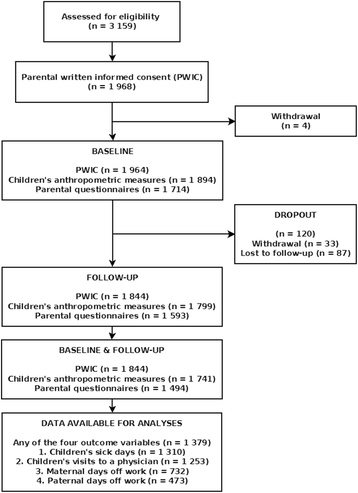Effects of statewide health promotion in primary schools on children's sick days, visits to a physician and parental absence from work: a cluster-randomized trial
- PMID: 27955648
- PMCID: PMC5153907
- DOI: 10.1186/s12889-016-3903-2
Effects of statewide health promotion in primary schools on children's sick days, visits to a physician and parental absence from work: a cluster-randomized trial
Abstract
Background: Based on the World Health Organization's global school health initiative we investigate intervention effects of statewide health promotion in schools on the numbers of children's sick days and visits to a physician, and parental days off work due to child illness.
Methods: Cluster-randomized trial with 1-year follow-up in primary schools in the state of Baden-Württemberg, Germany. Anthropometric measurements of first and second grade school children were taken by trained staff. Parents filled in questionnaires for information about socio-demographics, health-related variables, numbers of children's sick days, visits to a physician, and days parents had to stay off work to care for a sick child. Longitudinal differences in the outcome variables were calculated between baseline and follow-up. Intraclass correlation coefficients were determined to quantify a possible clustering of data in schools. Accordingly, linear models and linear mixed models were applied to identify relationships and ascertain significances.
Results: Data from 1943 children (1st grade n = 1024, 6.6 ± 0.4 years old; 2nd grade n = 919, 7.6 ± 0.4 years old) were available at baseline. Unadjusted differences regarding both grades were found between mean longitudinal changes in intervention and control group in children's sick days (-3.2 ± 7.1 vs. -2.3 ± 5.6, p = 0.013), and maternal days off work (-0.9 ± 2.4 vs. -0.5 ± 2.8, p = 0.019). The intervention effect on sick days was adjusted in a linear regression for baseline values, gender and migration background and confirmed for first grade children (B = -0.83, p = 0.003). The intervention effect on maternal days off work lost its significance after adjusting for baseline values. No significant differences were detected in the numbers of children's visits to a physician and paternal days off work.
Conclusions: School-based health promotion slightly reduces sick days in first grade children. Subsequently, parents may not need to stay off work themselves. Small individual effects add up to larger benefits in a statewide implementation of health promotion. Additionally, health promotion may also positively contribute to school success.
Trial registration: The study was registered on the German Clinical Trials Register (DRKS), Freiburg University, Germany, under the DRKS-ID: DRKS00000494 . Registered: 25 August 2010.
Keywords: Child; Health promotion; Parents; Physicians; Schools; Sick leave; Utilization.
Figures


References
-
- World Health Organization (WHO). School and youth health. 1995. http://www.who.int/school_youth_health/gshi/en/. Accessed 2 Dec 2015.
-
- Stewart-Brown S. What is the evidence on school health promotion in improving health or preventing disease and, specifically, what is the effectiveness of the health promoting schools approach? WHO Regional Office for Europe. Copenhagen. 2006. http://www.euro.who.int/document/e88185.pdf. Accessed 22 Feb 2016.
-
- Kesztyüs D, Wirt T, Kobel S, Schreiber A, Kettner S, Dreyhaupt J, et al. Is central obesity associated with poorer health and health-related quality of life in primary school children? Cross-sectional results from the Baden-Wuerttemberg Study and The “Komm mit in das gesunde Boot -Grundschule” -Research Group. BMC Public Health. 2013;13:13. doi: 10.1186/1471-2458-13-260. - DOI - PMC - PubMed
Publication types
MeSH terms
Associated data
LinkOut - more resources
Full Text Sources
Other Literature Sources
Medical

